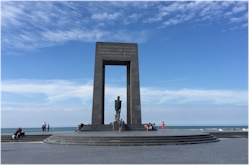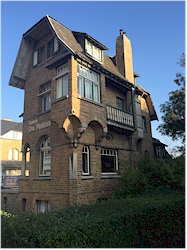|
Picture: the coastal promenade in Panne |
|
» Spending the night » Fixed events » De Nachtegaal » Calmeynbos » Oosthoekduinen » De Westhoek » Houtsaegersduinen » Overview... » Monument Leopold I » Military cemetary » Saint-Pieterschurch » Traces of the Great War » Garden quarter » Overview... » Tram museum » Nostalgic Media Museum » Scharbiellie » Overview... |
Monuments in De Panne
Military cemetary. The military cemetary is located right next to the civil cemetary on the road between the center of De Panne and Adinkerke. During the First World War, De Panne was located behind the frontline and there was a hospital where the wounded of the battlefield were taken care off. Soldiers are burried here that died in De Panne during the hostilities but also after the war, soldiers were burried here that were gathered from the wide area. There are 3739 tombstones mainly for Belgian soldiers and a few Brittish and French. Also 342 soldiers from the Second World War have been layed down to rest here.
Saint-Pieterschurch. The first church in De Panne served to provide religious services to the fishing village. The church does look older than it actually is. It was built in in neo-gothic style in the 19th century and shares a lot of similarities with other churches in the area.
Traces of the Great War. During the First World War, De Panne lay behind the frontline in the only part of Belgium that was not occupied. A hospital was established here to take care of the wounded and the king of Belgium resided here for the duration of the war. There are several monuments that remind the role that De Panne had during that war (such as the chapel of the friars "oblaten" that was also given the name of "the royal chapel"). There is also still an underground shelter in the Sint-Elisabethlaan.
|
» How to get to De Panne » Transport, tours, links,... » Adinkerke » De Panne
|
|
©
xplorengo.com. No information or pictures can be copied or distributed in any way
without written permission of xplorengo.com.
|
 Monument
Leopold I.
This is undoubtedly the most well-known monument of De Panne.
It was on this spot that Leopold I, the first king of Belgium,
set foot on land in his new country for the first time.
That was on July 17, 1831. To commemorate this event, this
impressive monument was created which can be found at the end of
the Leopold-I
esplanade.
Monument
Leopold I.
This is undoubtedly the most well-known monument of De Panne.
It was on this spot that Leopold I, the first king of Belgium,
set foot on land in his new country for the first time.
That was on July 17, 1831. To commemorate this event, this
impressive monument was created which can be found at the end of
the Leopold-I
esplanade.  The
garden quarter and the bel époque in
De Panne. The coastal resort was founded at the
end of the 19th century, at a moment when beach tourism in
Belgium started to become popular. A part of the dunes was
parceled out and the settlement was designed as a "garden city"
in order to limit the impact on nature. By the end of the
19th century, the first villas were built and nowadays, there
are still quite a few buildings left in cottage style, art deco,
art nouveau and modernistic style. These architectural
styles gives De Panne its unique appearance. For those who
are interested, the Tourism Office lined out a walk based on
these architectural marvels (ask for the Dumont walk).
The
garden quarter and the bel époque in
De Panne. The coastal resort was founded at the
end of the 19th century, at a moment when beach tourism in
Belgium started to become popular. A part of the dunes was
parceled out and the settlement was designed as a "garden city"
in order to limit the impact on nature. By the end of the
19th century, the first villas were built and nowadays, there
are still quite a few buildings left in cottage style, art deco,
art nouveau and modernistic style. These architectural
styles gives De Panne its unique appearance. For those who
are interested, the Tourism Office lined out a walk based on
these architectural marvels (ask for the Dumont walk).